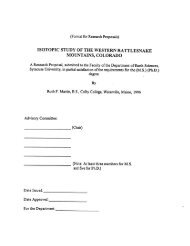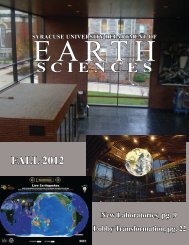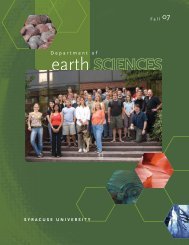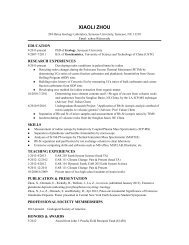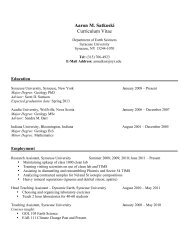alumni reception - Syracuse Universe Department of Earth Sciences ...
alumni reception - Syracuse Universe Department of Earth Sciences ...
alumni reception - Syracuse Universe Department of Earth Sciences ...
Create successful ePaper yourself
Turn your PDF publications into a flip-book with our unique Google optimized e-Paper software.
doing this work, and I would like to thank those who<br />
have contributed to the Endowed Student Research<br />
Fund, as well as the <strong>Department</strong> <strong>of</strong> <strong>Earth</strong> <strong>Sciences</strong>, for<br />
awarding me this grant.<br />
Xuewei Zhang<br />
I worked for Anadarko China as an Exploration<br />
geologist prior to being enrolled in the Ph.D. program<br />
in <strong>Earth</strong> <strong>Sciences</strong> at SU in fall 2009. From Insider<br />
Anadarko, I had the opportunity to take a close look at<br />
many <strong>of</strong> Anadarko sponsored G&G consortia projects<br />
with universities and academic institutes around the<br />
world. The Lacustrine Rift Basin research program<br />
directed by Pr<strong>of</strong>. Scholz was one <strong>of</strong> those projects.<br />
I was very interested in the cool research done by<br />
the group and wanted to get involved, and that’s<br />
why I made my way to <strong>Syracuse</strong>. I found <strong>Syracuse</strong><br />
University by chance, but I chose to be here following<br />
my heart.<br />
As expected, my first year in the Dept. <strong>of</strong><br />
<strong>Earth</strong> <strong>Sciences</strong> has been pretty exciting and fruitful:<br />
the courses I have taken, the exposure to various<br />
department colloquia and activities, all the field trips<br />
we made, and <strong>of</strong> course the research in which I have<br />
participated within the Lacustrine Rift Basin group,<br />
all helped reshape the way I am thinking as an <strong>Earth</strong><br />
scientist. One particular project, probably one <strong>of</strong> my<br />
Ph.D. projects, I am currently working on is a global<br />
study on sublacustrine channel and fan systems. The<br />
key issues we want to address include: what favors the<br />
initiation <strong>of</strong> sublacustrine channel and fan deposits;<br />
what accounts for the architectural and morphological<br />
differences (e.g., sinuosity <strong>of</strong> subaqueous channels)<br />
among these deep lake channel-fan systems; and are<br />
there quantitative relationships between channel-fan<br />
morphologies and geological parameters. It will be<br />
very challenging to characterize these sublacustrine<br />
channel-fan systems that show a wide range <strong>of</strong> age,<br />
location, and post-depositional process. Hopefully we<br />
can find some interesting results.<br />
Alex Zirakparvar<br />
During the past year, I have continued to<br />
make progress towards completing my PhD degree.<br />
I am working under Suzanne Baldwin, who has an<br />
NSF grant to study the formation and exhumation <strong>of</strong><br />
metamorphic rocks in Papua New Guinea.<br />
In October, I passed the PhD qualifying exam.<br />
Jeff Vervoort, who is a faculty member at Washington<br />
State University, was my former M.S. advisor, and is<br />
currently a member <strong>of</strong> my PhD committee, attended<br />
the examination. During Jeff’s visit to <strong>Syracuse</strong>, we<br />
were able to finalize the preparations to a manuscript<br />
that we submitted to <strong>Earth</strong> and Planetary Science<br />
Letters. As <strong>of</strong> this time, the manuscript is still in<br />
review, but I hope that it gets accepted, as this will<br />
bring me one step closer to completing my degree.<br />
During the last year, I also finally published the<br />
results <strong>of</strong> my Masters thesis in the Canadian Journal<br />
<strong>of</strong> <strong>Earth</strong> Science (see Zirakparvar et al., 2010 in CJES<br />
vol. 47). In February <strong>of</strong> this year, I was also chosen<br />
to attend a National Science Foundation sponsored<br />
workshop for the ion microprobe at the University <strong>of</strong><br />
California, Los Angeles. I learned a lot about the use<br />
<strong>of</strong> ion microbeam techniques during this workshop,<br />
and decided to present a bit <strong>of</strong> what I had learned at<br />
the department’s informal graduate seminar after I<br />
had returned from this workshop. I will be traveling<br />
to UCLA again in July <strong>of</strong> this year to perform U-Pb<br />
analyses <strong>of</strong> zircons, and will be making use <strong>of</strong> some<br />
<strong>of</strong> the latest developments in resolving the spatial<br />
distribution <strong>of</strong> U-Pb ages in single zircon crystals that<br />
the team at the UCLA has been working on. I also<br />
traveled to the GeoAnalytical lab at Washington State<br />
University to perform geochemical analyses. At this<br />
Alex collecting samples and data in<br />
Papua New Guinea.<br />
time I would also like to thank the Graduate Student<br />
Publication Award and Marjorie Hooker Award funds,<br />
since I received cash awards from both <strong>of</strong> these<br />
sources this year.



